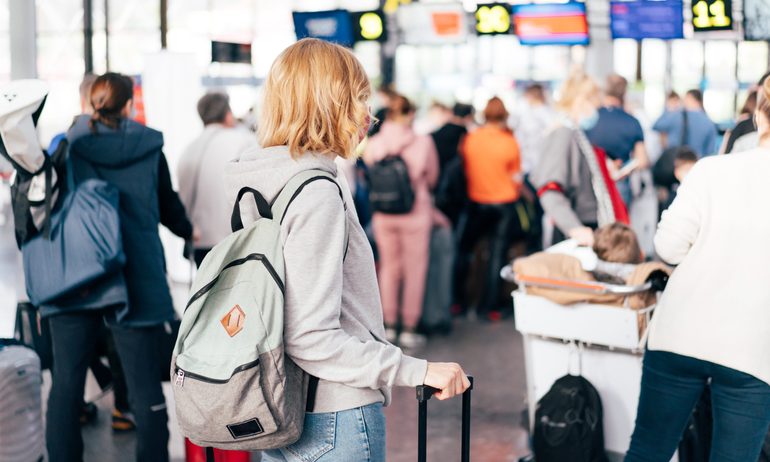Ask a Travel Nerd: How Can U.S. Airport Terminals Be Better?
Airport terminals across the country need improvements, starting with better infrastructure and quiet airport programs.

Many or all of the products on this page are from partners who compensate us when you click to or take an action on their website, but this does not influence our evaluations or ratings. Our opinions are our own.
Travelers are flocking away from overcrowded airport terminals and into airport lounges. And so, these lounges have a problem. The exclusive spaces that purportedly offer a refuge from packed airports have become just as chaotic as the general terminals.
Overrated or not, airport lounges still tend to stand superior to most airport terminals. In a lounge, travelers can at least munch on a cheese cube without boarding announcements blaring from the loudspeaker.
As a result, people go to great lengths to enter them. They pay hundreds of dollars in annual fees for credit cards that offer lounge access. They linger outside lounges until their names are off the waitlist.
But now, lounge operators have had to step in to reduce overcrowding. Many lounges often have standing room only, while other lounges enforce entry waitlists to prevent the problem entirely. In 2023, Delta Sky Club increased membership and guest fees and put a limit on how many hours people can spend in the lounge. Meanwhile, American Express made its Centurion Lounge guest policy more stringent to cut back on how many people can gain access.
The problem isn’t so much an obsession with airport lounges. Instead, it’s that most U.S. airport terminals are abysmal for a variety of reasons.
Reduced resources and dated design impact terminals
U.S. airports have a backlog of both approved and necessary infrastructure improvements that's projected to cost $151 billion, according to Airports Council International-North America (ACI-NA), an airport trade association that represents about 300 airports in the U.S. and Canada. That’s a 31% increase from the $115 billion backlog cited in 2021. ACI-NA has pointed to inflation as one reason that figure ballooned.
A key revenue source for airport upkeep and maintenance is a passenger facility charge, which Congress capped at $4.50 per ticket. When the charge was introduced in 1992, it was just $3, but the charge hasn’t been increased since 2001.
For context, $4.50 in 2001 would be more than $7.50 today, according to the consumer price index, giving some reason to believe that the cap should be increased to align with today’s equivalent purchasing power.
When the COVID-19 pandemic cut travel, airports lost income from reduced passenger facility charges, as well as other revenue streams like parking and rental car fees, retail sales and concessions. Even with funding, implementing airport improvements can be slow.
“Overregulation of airport land use decisions have delayed project approvals,” according to the ACI-NA’s 2023 U.S. Airport Infrastructure Needs Report.
Airport design significantly changed after 9/11. The establishment of the Transportation Security Administration (TSA) in November 2001 led to a greater physical footprint for security checkpoints. Unpredictable queues have also increased the number of people in airports, as passengers who might previously have shown up 30 minutes before boarding now arrive much earlier, with hours to spare.
How to make U.S. airports better
If funding weren't an issue, what improvements could make airport terminals more appealing than lounges?
Activities to pass the time
Singapore’s Jewel Changi Airport won a Tripadvisor Travelers’ Choice award as one of the country’s top attractions. The airport has a seven-story indoor waterfall, a rock wall and a hedge maze.
Airports don’t need to resemble a runway-lined Disneyland, but the best ones have amenities that are especially relevant during long flight delays, like yoga rooms, live music and museums.
Higher ceilings and bigger windows
Not every airport has the benefit of sitting within Grand Teton National Park, but Wyoming's Jackson Hole Airport — considered one of America's most charming airports — takes full advantage with soaring windows that frame the mountain range.
Even without picturesque views, other airports could curtail traveler anxiety and claustrophobia with higher ceilings and outdoor seating. Delta Sky Clubs' Sky Decks are a good example of how airports could build a compelling outdoor space.
Quiet airport programs
In 2018, San Francisco International Airport (SFO) launched a Quiet Airport program. It cut back on sounds emitted from retailers and gate agents, including a reduction in audio paging and boarding announcements for passengers.
Within two years of implementation, SFO officials said that more than 90 minutes of unnecessary announcements had been eliminated daily in its international terminal alone, which they claim makes air travel less stressful for passengers.
Better food
Starbucks and Sbarro might be concession staples, but the best airports are foodie destinations. The 2023 Global Tastemakers Awards from Food & Wine magazine named SFO the winner of Best Airport for Food in America. SFO hosts outposts of beloved local joints, including Ritual Coffee and vegetarian fast food favorite, Amy's Drive Thru (its owners also run the organic frozen food brand Amy’s Kitchen).
Even if the meals aren’t free (as they typically are in airport lounges), an order of Amy’s mac and cheese — whether the real stuff or vegan — is probably better than a cube of lounge cheese.
Sadly, these examples are the exception, not the norm. For now, options aren’t exactly promising for air travelers — either at crowded and chaotic airport terminals or crowded and chaotic airport lounges.
How to maximize your rewards
You want a travel credit card that prioritizes what’s important to you. Here are some of the best travel credit cards of 2025:
Flexibility, point transfers and a large bonus: Chase Sapphire Preferred® Card
No annual fee: Wells Fargo Autograph® Card
Flat-rate travel rewards: Capital One Venture Rewards Credit Card
Bonus travel rewards and high-end perks: Chase Sapphire Reserve®
Luxury perks: The Platinum Card® from American Express
Business travelers: Ink Business Preferred® Credit Card
Chase Sapphire Preferred® Card
Travel
Dining
🔥 Huge highest-ever bonus on NerdWallet's 2025 Best All-Purpose Travel Rewards Card is back. Don't miss your rare chance to: Earn 100,000 points when you spend $5,000 on purchases in the first three months. That's worth at least $1,250 toward travel booked through Chase.


